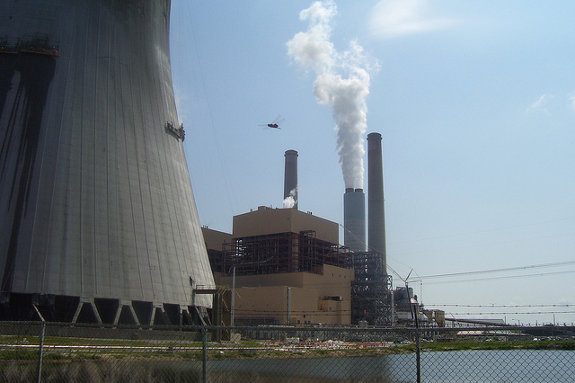
In October 2009, workers putting in a new steam generator at the Crystal River nuclear plant No. 3 found a crack in the 42-inch thick concrete wall of the containment building, which serves as the last line of defense in the event of a radioactive accident. (Photo courtesy of Progress Energy.)
By Ralph De La Cruz
Florida Center for Investigative Reporting
One of the most expensive nuclear accidents in United States history happened right here in Florida a little over two years ago. And chances are, you probably never even heard about it.
In October 2009, workers putting in a new steam generator at the Crystal River nuclear plant No. 3 found a crack in the 42-inch thick concrete wall of the containment building, which serves as the last line of defense in the event of a radioactive accident.
Six months later, another crack was found.
The Nuclear Regulatory Commission investigated the mysterious cracks and found they were the result of the procedure used by Progress Energy, which owns the Crystal River plant, to replace the steam generator.
The total cost of repairs for that mistake is now estimated to be $2.5 billion. Part of that is covered by insurance, but Progress wants customers to pony up $670 million of the costs because the cracks were an unforeseen consequence of the repair. In other words, it wasn’t the company’s fault.
The cracks “could not have been predicted,” Progress spokeswoman Suzanne Grant wrote to the St. Petersburg Times, which has been at the forefront of this story.
Last week, the Times published a stunning and well-sourced investigative piece that revealed a construction foreman named Charles Hovey had actually warned Progress months ahead of time about the procedures, and that they could damage the containment building.
Specifically, the two cracks developed because Progress did not follow the standard protocol for loosening the tension in steel “tendons” that line the walls. They loosened fewer of those cables than had been the norm in the 34 other steam generation replacements (all successful). And they loosened them out of order. Apparently all to save time and money.
When the engineering firm hired to develop the procedures for the generator replacement called for the loosening of what Progress felt was too many cables, John Holliday, the man responsible for the containment building job, told them “to put on their thinking caps and determine if there is an alternative method of analysis that we could pursue that would result in a lot less tendons being de-tensioned.”
And they did indeed come up with a lower number. But not with the expected cost savings. The shortcut resulted in the plant not being able to produce electricity for more than two years, and the cost is so overwhelming that Progress is now even considering shuttering the plant.
Now, state Sen. Mike Fasano wants Progress to come before the senate utilities committee and explain itself.
And state Rep. Michelle Rehwinkel Vasilinda has re-introduced a bill that would rescind a state law allowing state regulators to order customers to pay for the construction costs of nuclear power plants even if those plants never get built. Progress has been billing its customers for a yet-to-be-built $20 billion plant in Levy County.
For her troubles, Vasilinda has been removed from the A-list for a Democratic Party shindig at Progress’s sky box for the Florida State University-Virginia college football game.
Fasano also won’t be there, but not just because of his confrontational relationship with Progress. He’s a Republican.
